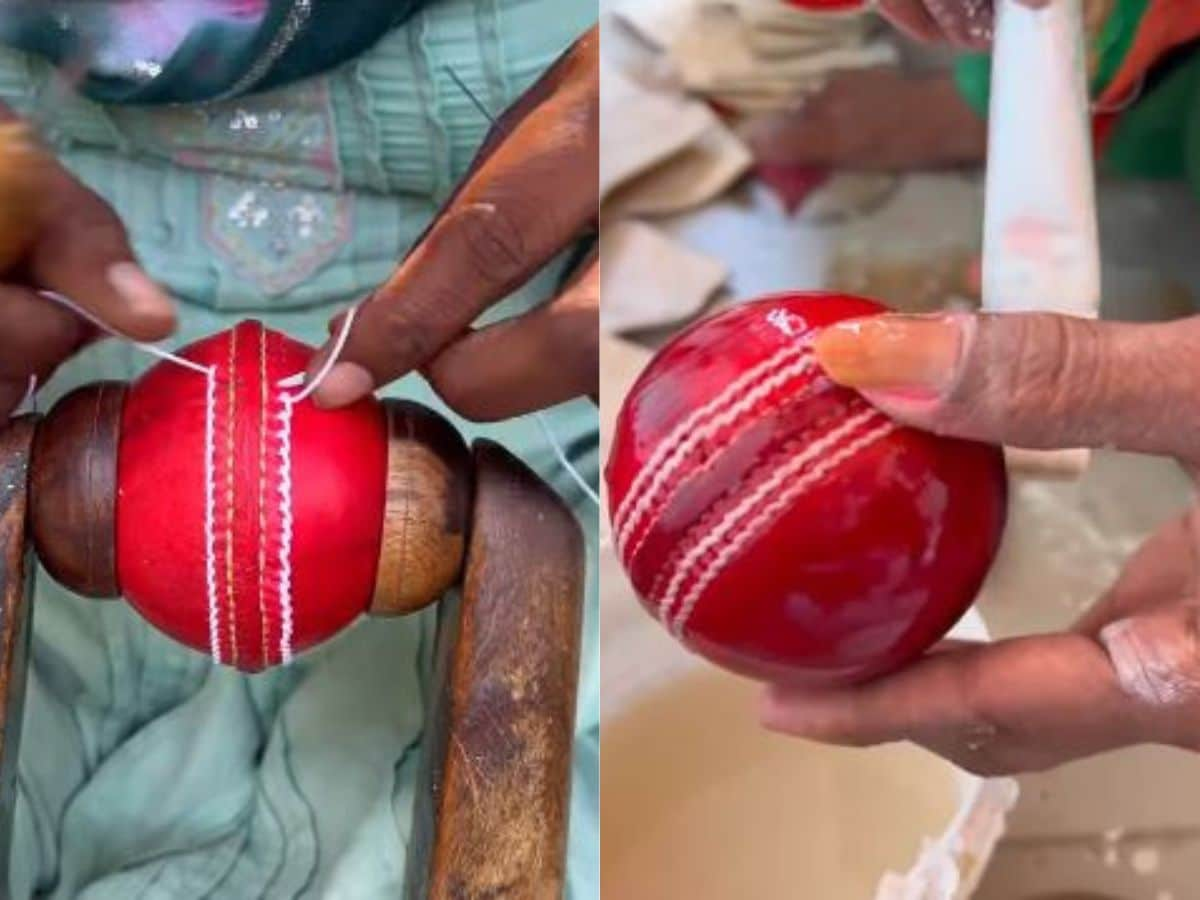What Is A Cricket Ball Made Of?: Complete Making Process: The ball plays an important role in the game of cricket because without the ball it is not possible to play the game. There are different types of cricket balls available such as red ball, white ball, Duke ball and Kookaburra ball to name a few.
But do you know how cricket balls are made? Or if you want to know What Is A Cricket Ball Made Of? So you should read this article till the end.
Like planets, cricket balls are also made of different layers. The different layers come together to form the shape of a sphere. Nowadays, balls are rarely handmade.
Unlike the old days, when craftsmen shaped the leather and sewed the seams with their hands, nowadays machines are mainly used to do the work. This proves to be a much more efficient and faster process.
Read More: Orbit Exchange
Manufacturing Process Of Cricket Ball:
- In the initial stages of preparing the ball, a small, round, central sphere of cork is taken.
- A bit of wire is wound tightly around it. This is done until the ball reaches a certain width.
- The outer portion of the leather is now applied before the ball is sewn on.
- This step in the process is where some of the differences in the process occur. Some manufacturers use a
- Machine to sew while others will continue to finish the ball by hand.
- The ball is then polished until a high shine is achieved.
- Finally, the manufacturer’s branding is affixed to the surface and the ball is finally finished.
What Is A Cricket Ball Made Of?
As mentioned earlier, there are many layers to the cricket ball. A variety of ingredients are used in their preparation. Let us learn about the materials used in the preparation of a standard cricket ball:
Cork Center
A hard-sphere of cork is used in the centre of the cricket ball. This is done because cork is a hard and durable material. Additionally, the cork is reinforced with rubber for added stiffness.
The Duke’s manufacturer of cricket balls, which produces balls for professional games in the United Kingdom, often does not rely on machine-made cork for the ball, and the rubber is imported from Malaysia, a major supplier of rubber.
The cork is the smallest part of the ball, but it is important because it is the central part of the ball. Since it serves as the foundation, care must be taken to ensure its structural integrity.
Thread

A tightly wound yarn/string is used in a later stage of the manufacturing process. Although it may not seem that important, the wound of the thread is a very important aspect of ball preparation, this is because the strength of the thread is significant in determining the weight and stiffness of the ball.
Leather Outer
The famous saying about the sound of ‘leather on willow’ comes from this aspect of the ball. A leather exterior surrounds the cork and strings. It is this outer part of the leather that provides the surface of the ball.
Mostly, cow leather is used in this phase of the manufacturing process. This is a general criterion for external preparation. However, in some odd instances, buffalo or ox leather is also used.
It is noteworthy that the Duke brand sources its leather from an exclusive tannery in Scotland, which is believed to provide the best leather.
Four sections of leather are used on the surface. For red balls, there should be four equal quarters of leather, while for white balls it is possible to use two pieces of leather. It is this difference that also results in differences in the durability of the balls.
Maintaining thickness is also very important here. For the deux ball, the leather can be between 4 mm and 4.5 mm thick; While for other balls, particularly those made and used in the subcontinent, the surface may be between 2 mm to 3 mm.
Stitching Process
In the final step, the leather surface is sawn into place through a sewing process. The seam sews the leather as it goes around the circumference of the ball.
As mentioned earlier, most of the preparation is done by machines; However, some elements such as stitching are still done by hand.
For example, with the Duke ball, there are six different lines around the perimeter of the ball and they are all hand-stitched. It is a very meticulous and time-consuming process, however, it ensures the high quality of the product.
Polishing
And finally, finally, the leather is very well polished, giving it a nice clean shine. Many brands use a special type of grease while shining the ball. This grease prevents the ball from taking up moisture, ensuring the longevity and high quality of the balls.
Although the process may vary slightly, for companies like Duke, Kookaburra, or even SG (Sansparilles Greenlands), the overall process remains more or less the same.
Different Types of Cricket Balls:

- Red ball (used primarily for Test cricket, and first-class cricket)
- White ball (used for ODI, and T-2O, etc.)
- Pink ball (recently introduced and finds use in Test cricket)
FAQ
What type of leather is used to make cricket balls?
Ans.: Cricket balls are traditionally made using high-grade leather, often obtained from cows. The leather used must be durable, have the right texture, and have good water resistance properties to withstand the rigours of the game.
What is the role of cork in cricket balls?
Ans.: Cork is the basic form of a cricket ball and is responsible for its weight and bounce. The cork core is compressed and shaped into a hemisphere, giving the ball its distinctive round shape and ensuring that it maintains its bounce during play.
Do all cricket balls weigh the same?
Ans.: Cricket balls come in various weights to suit different formats of the game. Test match balls typically weigh between 155.9 to 163 grams, while limited overs match balls weigh slightly lighter, ranging between 142 to 156 grams.
Are cricket balls made differently for different pitch conditions?
Ans.: Cricket balls may be slightly adapted depending on pitch conditions and environmental factors. For example, in countries with humid conditions, manufacturers may use additional water-repellent treatments on leather to prevent excessive absorption. Similarly, changes can be made to the construction of the ball to adapt to different pitch types, such as using a softer core for slower pitches or a harder core for faster pitches.
Read More Articles:
- Orbit Exchange
- Orbit Exchange Reviews
- Sign In and Login In Orbit Exchange Portal
- Top 5 Betting Exchange Sites
- Orbit Exchange Account
- Orbit Exchange Commission
- Orbit Exchange Registration
- Online Betting On Orbit Exchange With Crypto
- Orbit Exchange Account Features
- Orbit Exchange Brokers
- How To Open An Orbit Exchange Account?
- Commission On Orbit Exchange
- Available Sports Games On Orbit Exchange
